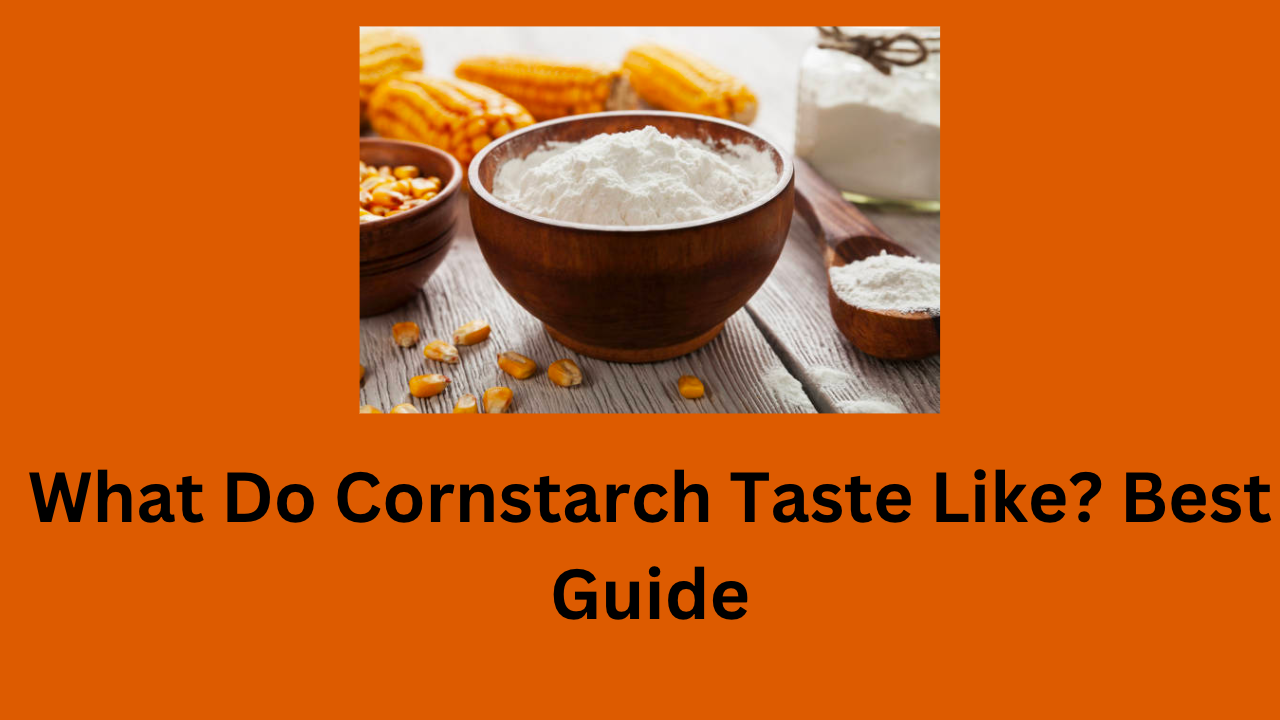Cornstarch is derived from the corn plant. It is a white, powdery carbohydrate substance used as a thickener in food products.
It is a dietary staple in some parts of the world, and it is also used as a biofuel and can also be used to make fabrics and paper.
When it is cooked, it is composed of long chains of glucose molecules which break down and thicken the liquid.
It can also thicken soups, sauces, puddings, and pie fillings.
Cornstarch has various uses in the food industry. It is used as a thickener in sauces, soups, and puddings and used to make gluten-free flour and to coat meats and vegetables before frying.
It also has other uses in the manufacture of adhesives, plastics, and textiles.
To answer your question, “what do cornstarch taste like?” keep reading!
What Is CornStarch Made Of?
Cornstarch is made from three parts of corn kernel: the endosperm, the germ, and the bran. The endosperm consists of starch, the germ contains the oil and the protein, and the bran contains the fiber.
All three parts of the kernel are combined to make cornstarch.
What Do Cornstarch Taste Like?
The flavor of cornstarch is best described as a bland, powdery flavor that tastes similar to any processed starchy flour.
This means that Cornstarch has no flavor and tastes “neutral.”
This can be traced to making cornstarch which requires multiple filtration steps.
Each of these reduces and removes the protein and fibers from the corn, leaving the end product nearly tasteless and bland.
The kernel is processed and removed during the wet-milling process; as such, cornstarch is left with almost no flavor.
However, there are some exceptions to the taste of cornstarch, depending on the brand you choose.
Some manufacturers of cornstarch may add some additives that may slightly change the texture and flavor of cornstarch.
How Is Cornstarch Made?
Corn contains natural starch, which is used in many industries and is a complex carbohydrate found in many different types of food
But in the food context, it is usually used to thicken food or to add crispiness via frying or texture via baking.
The process of making cornstarch begins with removing the corn kernel from the cob; it is processed depending on the type of corn at hand.
The kernels are hydrated in water before processing to aid in the grinding process, which is referred to as “wet-milling.”
It is used to separate the various products or byproducts of corn and the production of corn oil!
Once the kernels enter into a large grinding machine that efficiently grounds the corn until it is homogenous, the resulting mixture is filtered, and the residue is set aside.
The watery mixture is processed and filtered using an even finer mesh filter to separate the endosperm and its constituents.
The mixture consists of mostly water and starch, which is left to separate naturally.
The starch settles down at the bottom while the water remains on top.
The excess water is drained, and the wet, starchy slurry is dried.
The dried starch is then ground a final time before it is packaged and shipped across the country!
How to Make Cornstarch At Home
Ingredients Needed
- Corn Kernels
- Water
- Fine-mesh
- Grinder
Instructions
- Property rinse the kernels to remove any residue or dirt.
- Soak the kernels in water and leave them to hydrate for at least 2 hours or more (if they don’t soften after the two-hour mark)
- Drain the wet kernels and add them to a grinder along with a bit of water to cover half or ¾ of the kernels in the grinder.
- Grind the kernels until they have been processed to make the mixture as homogenous as possible.
- Filter the liquid using a fine mesh and then push down on the residue to release as much starch as possible.
- Filter the liquid again using a fine mesh filter over a cheesecloth and use the back of the spoon to squeeze out the starch to further separate the starch from the rest of the residue.
- Cover the mixture and let it rest undisturbed for about 2-3 hours.
- Pour out the liquid over a semi-solid slurry, then spread the semi-solid slurry over a large pan to thin out the liquid so that it is easier to dry.
- You can then use a dehydrator or even sun-dry the semi-solid slurry mixture.
- Scrape the surface of the pan to release the powder and check the cornstarch for any signs of moisture.
- Once fully dry, put the powder in a grinder and use the pulse setting to process it until you get a smooth and uniform powder mixture.
- You can store the cornstarch in an airtight jar and keep it away from moisture, direct sunlight, and air.
How To Use Cornstarch
Cornstarch can be used for:
- Cooking
It is commonly used to thicken liquids and in fried chicken batter, and even on French fries too!
It is used with an all-purpose flour mix to create a light but extremely crispy exterior coating.
- Baking
Cornstarch is also used in pie fillings, brownies, cookies, and more.
It helps add texture to baking goods as it makes the surface noticeably crumblier and a bit crispier too!
It also adds an excellent bite and provides more texture than baking goods made without cornstarch.
Health Benefits Of CornStarch
Corn starch is a white, powdery carbohydrate substance used in cooking and baking.
With its neutral taste, it has several health benefits, some of which are:
- It is a good source of carbohydrates, which are necessary for energy.
- It is low in fat and calories, which makes it a healthy choice for those watching their weight.
- Because it is a good source of fiber, it can help to regulate the digestive system.
- Also, it is a good source of vitamins and minerals, including iron, magnesium, and phosphorus.
- It is non-toxic and biodegradable, making it safe to consume and an environmentally friendly product.
How To Store Cornstarch?
Cornstarch can be stored in an airtight container in a cool, dry place.
It is not recommended to be stored in the fridge or freezer as it will cause it to harden.
Airtight containers help to keep the powdery substance dry and prevent it from clumping.
Also, you can store it in a dark and cool place because light and heat can cause the starch to go bad and spoil.
A pantry is also one of the best places to store cornstarch because it is generally dark and cool, which is ideal for storing starches.
Conclusion
Cornstarch is a powder starch derived from the endosperm of corn kernels. It has a bland, slightly sweet taste and is used as a thickener in sauces, soups, and desserts.
It forms a gel-like substance that can be used to thicken or stabilize food. Also, it is used in the production of corn syrup and other sweeteners.
It has a neutral taste and a slightly chewy texture.
It’s relatively flavorless and can be used in dishes that will be flavored with other ingredients.
Cornstarch is also used as a coating for fried foods. It helps to create a crispy outer layer that seals in moisture and flavor.
There are many different ways to use cornstarch. It can be used to thicken soups, sauces, and gravies.
It can also be used to make pie fillings and puddings thicker and coats for fried foods, such as chicken or fish.
Cornstarch can be stored in an airtight container in a cool, dry place, in a dark and cool place, because light and heat can cause the starch to go bad and spoil.
You can also store cornstarch in the pantry because it is generally dark and cool, which is ideal for storing starches.
You can make your cornstarch from home following the ingredients and instructions above or buy ready-made cornstarch from the grocery store.
We hope you find this guide on “what do cornstarch taste like?” helpful.
Don’t forget to check back for a more interesting recipe guide.
FAQS
Can I make cornstarch using any corn species?
You can make cornstarch using any type of corn so long as you hydrate it before use.
Commercial kernels or any other type of unrefined or unprocessed kernel as well are not left out.
Can cornstarch go bad?
Cornstarch is usually made dry; as such, it can resist bacterial growth but can be compromised if exposed to air or moisture.
It can develop mold and even harbor harmful bacteria if not properly stored or cooked before consumption.
Is Corn starch Gluten Free?
Yes, corn starch is gluten-free as it is made from the corn kernel and does not contain gluten.
Is Cornstarch Bad For health?
Cornstarch is generally considered safe to eat, but it may not be the healthiest choice as it contains carbohydrates.
It is a source of energy and can help you feel full after eating. It also contains calories which may not be the best choice if you’re trying to lose weight or manage diabetes.
What Can I Substitute For Cornstarch?
You can use Arrowroot, potato starch, and tapioca starch as substitutes for corn starch. Tapioca starch is the best because it has a neutral flavor and thickens at a lower temperature than the other starches.
In addition, it can be used as a stabilizer in puddings and pie fillings.

